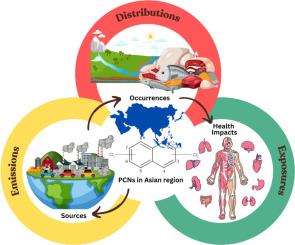调查亚太地区多氯萘(PCNs):对来源、发生和健康影响的审查
IF 8
1区 环境科学与生态学
Q1 ENVIRONMENTAL SCIENCES
引用次数: 0
摘要
多氯萘是一类具有高度环境持久性、生物蓄积性和显著毒理学效应的持久性有机污染物。从历史上看,由于其稳定性和兼容性,pcn已在各种电气和工业应用中用作绝缘体和阻燃剂。尽管实施了诸如“逐步淘汰政策”和关于持久性有机污染物的《斯德哥尔摩公约》等全球监管举措,但其遗留污染和持续排放继续构成环境和公共健康风险,特别是在亚洲。本综述调查了目前关于快速发展和人口密集的亚洲城市地区PCNs的来源、发生和健康影响的知识。我们的研究结果表明,冶金工业是pcn的主要来源,占总排放量的97%以上,其次是热过程,历史使用和电子废物回收活动的新关注。发现在环境分布中,较低的氯化PCN同系物(单氯到四氯)水平在fg到ng水平之间存在显著差异,导致工业区附近的空气、土壤、水、沉积物和生物群样本受到广泛污染。职业暴露与癌症风险增加(CR)有关,而在婴儿和儿童等易感人群中观察到非CR升高。摄入是主要的接触途径,通过食用受pcn污染的食物发生。PCNs暴露显示出潜在的健康风险,包括致癌性、神经毒性、内分泌干扰和生殖障碍。本综述强调需要进一步研究新出现的潜在来源、纵向环境监测和流行病学研究,以评估亚洲地区PCN暴露对健康的影响。本文章由计算机程序翻译,如有差异,请以英文原文为准。

Investigating polychlorinated naphthalenes (PCNs) in Asia Pacific regions: A review of sources, occurrences and health impacts
Polychlorinated naphthalenes (PCNs) are a class of persistent organic pollutants (POPs) that can exhibit high environmental persistence, bioaccumulation properties and significant toxicological effects. Historically, PCNs have been used as insulators and fire retardants in various electrical and industrial applications due to their stability and compatibility. Despite the implementation of global regulatory initiatives such as the ‘phase-out policy’ and Stockholm Convention on POPs, their legacy contamination and ongoing emissions continue to pose environmental and public health risks, especially in Asia. This review investigated current knowledge on the sources, occurrences and health impacts of PCNs in rapidly developing and densely populated urban Asian regions. Our findings indicate that metallurgy industries are the major source of PCNs, contributing over 97 % of total emissions, followed by thermal processes, historical usage and emerging concerns of electronic waste recycling activities. Lower chlorinated PCN congeners (mono to tetra) levels were found to vary significantly from fg to ng levels in environmental distribution, contributing to the extensive contamination of air, soil, water, sediments and biota samples in proximity to industrial areas. Occupational exposure was associated with increased cancer risks (CR), while elevated non-CR were observed in vulnerable populations such as infants and children. Ingestion was the primary exposure route, occurring through consumption of PCNs contaminated food. PCNs exposure showed potential health risks including carcinogenicity, neurotoxicity, endocrine disruption and reproductive disorders. This review highlights the need for further research on emerging potential sources, longitudinal environmental monitoring and epidemiological studies to evaluate health impacts of PCN exposures in Asian regions.
求助全文
通过发布文献求助,成功后即可免费获取论文全文。
去求助
来源期刊

Science of the Total Environment
环境科学-环境科学
CiteScore
17.60
自引率
10.20%
发文量
8726
审稿时长
2.4 months
期刊介绍:
The Science of the Total Environment is an international journal dedicated to scientific research on the environment and its interaction with humanity. It covers a wide range of disciplines and seeks to publish innovative, hypothesis-driven, and impactful research that explores the entire environment, including the atmosphere, lithosphere, hydrosphere, biosphere, and anthroposphere.
The journal's updated Aims & Scope emphasizes the importance of interdisciplinary environmental research with broad impact. Priority is given to studies that advance fundamental understanding and explore the interconnectedness of multiple environmental spheres. Field studies are preferred, while laboratory experiments must demonstrate significant methodological advancements or mechanistic insights with direct relevance to the environment.
 求助内容:
求助内容: 应助结果提醒方式:
应助结果提醒方式:


